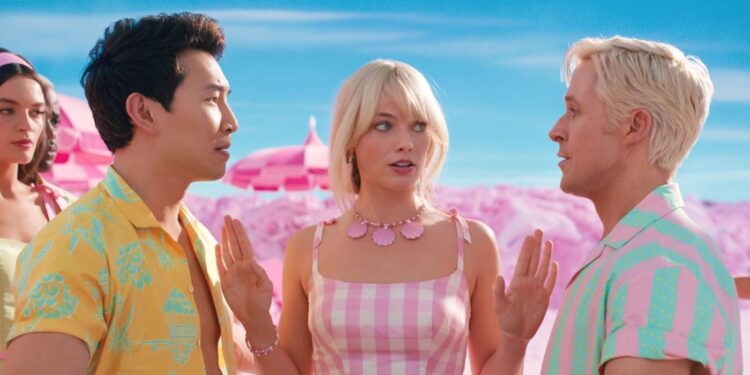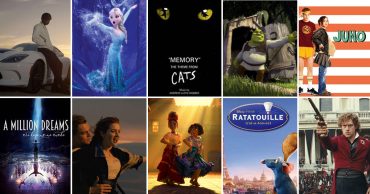Before Barbie turned pink into profit, Margot Robbie had already built a sharp reputation as one of Hollywood’s most versatile performers. From The Wolf of Wall Street (2013) to I, Tonya (2017), she transitioned from breakout actress to serious producer through her company LuckyChap Entertainment.
That move changed everything. By producing projects like Promising Young Woman and Birds of Prey, Robbie wasn’t just collecting paychecks — she was taking equity stakes in her films. It’s this creative-business duality that positioned her perfectly when Barbie came along. When Barbie shattered records in 2023, earning over $1.45 billion worldwide, Robbie’s payday made headlines. But behind the headlines lies a new model of celebrity wealth — one built on ownership, not just stardom.
Breaking Down Margot Robbie’s Barbie Earnings

Image via LuckyChap Entertainment
According to Variety, Robbie earned an up-front salary of $12.5 million for starring in Barbie. However, as a producer, she negotiated a backend deal tied to the film’s massive success. Industry insiders told Variety that once box-office bonuses and profit participation are counted, her total payday could reach $50 million — one of the biggest for any actress in modern history. To put that in context: Ryan Gosling reportedly earned about $12.5 million for playing Ken, with no production cut. Robbie, by contrast, had her company’s name on the credits, meaning LuckyChap Entertainment earned additional producer fees and a percentage of profits.
This arrangement mirrors the kind of structure Tom Cruise used on Top Gun: Maverick and Robert Downey Jr. on the Avengers films — but seeing it executed by a female producer-star makes it a cultural landmark. Outside of Barbie, Robbie’s 2023 income included sponsorships from Chanel and Calvin Klein, as well as residuals from earlier films. Forbes listed her 2023 earnings at $78 million, confirming her status among Hollywood’s highest-paid.
Margot Robbie’s Current Net Worth and Assets

As of 2025, most financial trackers, including Forbes, Business Insider, and Celebrity Net Worth, estimate her fortune around $60 million to $65 million. However, that number doesn’t fully reflect her equity in LuckyChap or potential Barbie royalties that continue to accumulate through merchandise and streaming rights.
Robbie and her husband Tom Ackerley reportedly own multiple properties, including a $5 million Venice Beach home and real-estate investments in Australia. She’s also rumored to have quiet venture positions in creative studios tied to female-led storytelling. What distinguishes her finances isn’t just the zeros — it’s the structure. Instead of relying on one-off film checks, Robbie now controls a production pipeline that can pay her as an actor, producer, and rights owner.
Why Margot Robbie’s $50 Million Moment Matters

Robbie’s deal has become a template for female stars seeking equity rather than salary. By producing her own vehicle and negotiating backend points, she closed a historic pay gap without any public fight. Studios once feared giving too much power to actors. Now, with films like Barbie proving that ownership can drive authenticity and success, creative equity is trending across Hollywood.
Robbie’s story shows how modern celebrity wealth isn’t built on red-carpet appearances — it’s built on contracts, IP, and brand architecture. In essence, she turned Barbie from a toy story into a business case study.
How Margot Robbie’s Financial Strategy Is Redefining Hollywood Wealth

Dune: Part Two and Challengers highlight how peers are also chasing ownership models, but Robbie’s 2025 outlook is uniquely powered by LuckyChap’s slate. Robbie’s net worth in 2025 isn’t about the size of her bank account — it’s about the shift she symbolizes. By earning $50 million from Barbie and steering LuckyChap Entertainment into Hollywood’s top tier, she’s rewritten what financial empowerment looks like for A-list talent. Her success proves that when women own the IP, control the budget, and believe in the vision, the profits follow — in every shade of pink.
What’s more, Robbie’s success demonstrates how the economics of celebrity are shifting. Traditional stardom once depended on front-end salaries; now, equity participation and backend deals dictate who truly profits from billion-dollar franchises. The Barbie phenomenon has shown major studios that women-led projects can yield historic ROI, leading to more favorable deals for actresses and producers who can deliver both cultural impact and commercial gain. In other words, Robbie didn’t just make $50 million — she reset the negotiation floor for female talent.
 Follow Us
Follow Us





